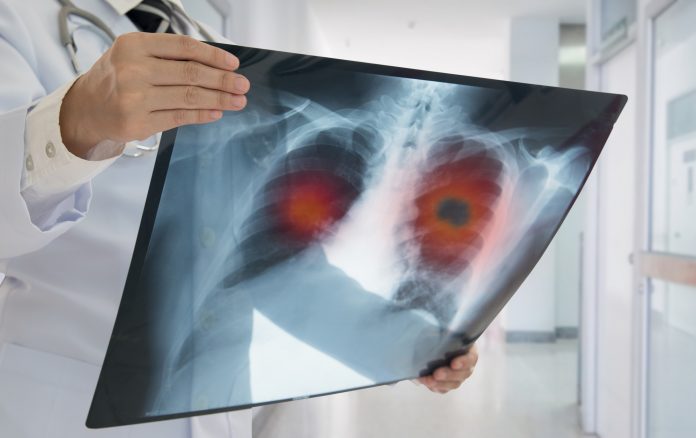
Researchers from the UCLA Health Jonsson Comprehensive Cancer Center have published new research in the journal JAMA Oncology demonstrating that chemotherapy plus high doses of radiation are a safe and effective treatment for people with locally advanced non-small cell lung cancer (NSCLC) that is not suitable for surgery.
The Jonsson team found that the combination treatment, which creates a second, personalized treatment plan to apply stereotactic ablative radiotherapy (SABR) concurrently with chemotherapy helps reduce both toxic side effects and the likelihood of the cancer returning.
“This treatment method explores uncharted territory,” said first author Trudy Wu, a radiation oncology resident at UCLA. “Our field has been moving towards hypofractionation across many disease sites; however, it is particularly challenging in locally advanced lung cancer due to the close vicinity of tumor to sensitive structures such as the airways and esophagus.”
One potential approach to preventing cancer form returning within the chest after local therapy is to deliver higher-dose radiation per single treatment in a more intense way.
“Using a novel adaptive boost technique personalized to an individual’s treatment response after the first two thirds of radiation treatment allows for a tighter conformal radiation boost plan and reduction of healthy tissue receiving radiation,” Wu added.
Looking to find the appropriate highest individualized boost dose that could be tolerated in patients while also effectively attacking each patient’s NSCLC, the UCLA team enrolled 28 patients in their study who had either stage II or stage III NSCLC. The patients were enrolled between May 2011 and May 2018 on an early phase does escalation trial. Patients received a base radiation dose of 4 Gy x 10 fractions followed by an SABR boost to target any remaining metabolically active cancer.
The boost dose for the first 10 patients received the low dose of 25 Gy comprising 5 Gy x 5 fractions. If, after a follow up period this dose was characterized as safe the patients were bumped up to an intermediate dose of 30 Gy (6 Gy x 5 fractions), then a high dose of 35 (7 Gy x 5 fractions). All were given with concurrent weekly chemotherapy.
The escalation served as a method to find and deliver the maximum tolerated dose, on a personalized basis, with the goal of improving progression-free survival while also shortening the treatment duration. The most promising results of this approach was seen in the cohort that received the intermediate dose. In this regimen the patients received a total of 70Gy in 15 fractions, including a 30 Gy boost, which showed a balance between side effects and treatment efficacy.
The intermediate dose-boost cohort did not exhibit any severe side effects from their treatment, though most patients experience some adverse effects such as fatigue, inflammation of the esophagus or lungs, or a sore throat and cough. Two patients in the high-dose cohort experienced severe side effects.
After two years, local-control rates were 74.1%, 85.7%, and 100.0% for the low-, intermediate-, and high-dose cohorts, respectively; and two-year overall survival was 30.0%, 76.2%, and 55.6%.
“Our data shows patients may benefit from targeted, high-dose radiation with chemotherapy if it’s done thoughtfully with adaptive radiation,” said Beth Neilsen, MD, an author of the study and a radiation oncology resident at UCLA. “For the intermediate dose regimen, the incidence of severe side effects was relatively low and showed potential for better local control of the cancer.”
The authors noted that the small study size and follow-up period were limitations of the study, though the promising results will spur future trials that will also include consolidation immunotherapy, now a standard of care protocol in this treatment setting.













